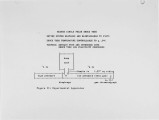| OCR Text |
Show the cleavage of the most highly substituted C-C bond, followed by rapid decomposition of the newly formed radical. The processes are as follows; (t-C4H9)2 -) 2 t-C4H9 and Thus for every hydrogen atom released into the system an isobutene molecule is formed. Furthermore, since we have previously determined the rate expression for hexamethylethane decomposition as1S k«t-C4H9)2 -) 2 t-C4H9)= 3 x 1016 Exp(-34S00/T) Is then from the yields of isobutene we can also establish an average temperature of the system since k«t-C4H9)2 -) 2 t-C4H9)=ln(1-2*iC4Ha/(t-C4H9)2)*1/t where t is the residence time of SOO microsecs. This is of key importance with respect to the reliability of rate expressions from single pulse shock tube experiments. Rate constants are exponentially dependent on temperature. Small errors in the latter can need to serious problems. We are using an internal standard to measure the temperature. There is no question that every molecule in the shock tube experiences the same temperature. Our target compounds react with the hydrogen atoms that are generated from hexamethylethane decomposition via displacement or abstraction of the weakly bond benzyl hydrogen bond (in our standard). For the present purposes we can ignore the latter except to remark that it is very necessary to have an ultimate sink for all the possible reactive species. The appropriate reactions are (in the case of chlorobenzene and 1,3,S trimethylbenzene) H + ClC6HS -) C6H6 + Cl H + (CH3)3C6H3 -) (CH3)2C6H4 + CH3 -) (CH3)2C6H3CH2 + H2 12 kdisp,Cl kdisp, CH3 |

























